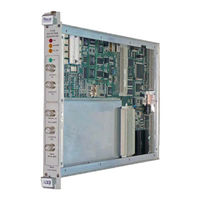Astronics Racal Instruments 3100R Manuals
Manuals and User Guides for Astronics Racal Instruments 3100R. We have 1 Astronics Racal Instruments 3100R manual available for free PDF download: User Manual
Astronics Racal Instruments 3100R User Manual (420 pages)
VXIbus Arbitrary Waveform Generator
Brand: Astronics
|
Category: Portable Generator
|
Size: 9 MB
Table of Contents
-
Chapter 1
28-
Introduction28
-
Introduction29
-
Run Modes34
-
Amplitude35
-
Options39
-
Output (Out)40
-
EXT 10Mhz41
-
Sweep44
-
Fsk45
-
Psk45
-
Ask45
-
Gated Mode47
-
Burst Mode47
-
Filters49
-
Output State49
-
-
Chapter 2
52-
Installation52
-
Installation55
-
-
Chapter 3
60 -
Chapter 4
100-
Arbconnection100
-
Main Window102
-
Control Panels102
-
Output105
-
Run Mode106
-
Standard108
-
Half Cycle118
-
Sweep122
-
Fsk/Psk/Ask124
-
Ampl/Freq Hop126
-
Auxiliary Panels128
-
Counter/Timer129
-
Pulse Generator130
-
General/Filters135
-
Calibration137
-
File Menu139
-
Edit Menu140
-
View Commands141
-
Wave Menu142
-
The Toolbar144
-
Typing Equations149
-
File Menu156
-
Edit Menu158
-
View Menu158
-
Tools Menu160
-
Creating Pulses160
-
The FM Composer172
-
The Menu Bar172
-
File Menu173
-
Wave Commands173
-
The 3D Composer175
-
-
Chapter 5
184-
Command Format185
-
AM Programming258
-
System Commands293
-
Error Messages304
-
Warm-Up Period309
-
Test Procedures309
-
Offset Accuracy314
-
Trigger Slope324
-
Trigger Level325
-
Step Advance327
-
Single Advance328
-
PLL Operation331
-
PM Operation334
-
PM Checks334
-
Waveform Memory335
-
Fsk341
-
Psk342
-
Ask342
-
Sweep345
-
Frequency347
-
Pulse Width348
-
Calibration350
-
Environment351
-
Configuration351
-
Warm-Up352
-
Procedure352
-
Warm-Up361
-
Procedure361
-
Initialization361
-
VCO Adjustments362
-
PLL Adjustments365
-
Outputs400
-
Main Output400
-
Sync Output400
-
Filters401
-
Sources401
-
Sine403
-
Triangle403
-
Square404
-
Pulse404
-
Ramp404
-
Gaussian Pulse404
-
Sync Pulse404
-
General405
-
Marker Output406
-
Sweep406
-
Arbitrary FM406
-
Fsk407
-
Psk407
-
Ask407
-
Totalize409
-
General409
-
Options410
-
General410
-
General412
-
Environmental413
-
Swept Waveforms416
-
Sampling Clock416
-
Phase Modulation417
-
Counter418
Advertisement
Advertisement
Related Products
- Astronics Racal Instruments 3152B
- Astronics Racal Instruments 3151B
- Astronics Racal Instruments 3100M
- Astronics Trig-Tek 346B
- Astronics RACAL INSTRUMENTS 1260-164AH
- Astronics RACAL INSTRUMENTS 1260-164BH
- Astronics RACAL INSTRUMENTS 1260-43
- Astronics RACAL INSTRUMENTS 1260-114 Series
- Astronics RACAL INSTRUMENTS 1260-114TTL
- Astronics RACAL INSTRUMENTS 1260-114MOS
